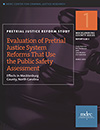Evaluation of Pretrial Justice System Reforms That Use the Public Safety Assessment
Effects in Mecklenburg County, North Carolina

 Arnold Ventures’ Public Safety Assessment (PSA) is a pretrial risk assessment tool that uses nine factors from a defendant’s history to produce two risk scores: one representing the likelihood of a new crime being committed and another representing the likelihood of a failure to appear for future court hearings. The PSA also notes if there is an elevated risk of a violent crime. The PSA is designed to provide additional information to judges and others making release decisions — decisions about whether a defendant will be released while waiting for a case to be resolved, and if so, under what conditions. The score is used in conjunction with a jurisdiction-specific decision-making framework that uses the defendant’s PSA risk score in combination with local statutes and policies to produce a recommendation for release conditions. The goal of the PSA is to make the restrictions on a defendant’s release conditions better align with that defendant’s assessed risk of committing new crimes or failing to appear.
Arnold Ventures’ Public Safety Assessment (PSA) is a pretrial risk assessment tool that uses nine factors from a defendant’s history to produce two risk scores: one representing the likelihood of a new crime being committed and another representing the likelihood of a failure to appear for future court hearings. The PSA also notes if there is an elevated risk of a violent crime. The PSA is designed to provide additional information to judges and others making release decisions — decisions about whether a defendant will be released while waiting for a case to be resolved, and if so, under what conditions. The score is used in conjunction with a jurisdiction-specific decision-making framework that uses the defendant’s PSA risk score in combination with local statutes and policies to produce a recommendation for release conditions. The goal of the PSA is to make the restrictions on a defendant’s release conditions better align with that defendant’s assessed risk of committing new crimes or failing to appear.
Over 40 jurisdictions across the country have implemented the PSA. Mecklenburg County, North Carolina was one of the first; it began using the PSA in 2014, switching from another risk assessment. This study presents the effects of the PSA and related policy changes in Mecklenburg County. The first report in the series describes the effects of the overall policy reforms on important outcomes. A supplemental second report describes the role of risk-based decision making in the outcomes and describes the effects of the PSA on racial disparities in outcomes and among different subgroups.
Overall, the findings are notable from a public-safety perspective: Mecklenburg County released more defendants and did not see an increase in missed court appointments or new criminal charges while defendants were waiting for their cases to be resolved.
-
The PSA policy changes were associated with less use of financial bail and a higher rate of defendants being released on a written promise or unsecured bond. The proportion of defendants detained in jail was lower than it would have been in the absence of the policy changes. There was an improved alignment between defendant risk and the restrictiveness of release conditions.
-
Fewer cases resulted in guilty pleas and convictions than would have been the case in the absence of the reforms. Because more defendants were released while their cases were pending, they may have had less incentive to plead guilty in order to get out of jail.
-
Even though the PSA policy changes increased the percentage of defendants who were released pending trial — and even though a higher proportion of defendants were facing felony charges in the period after the PSA was implemented — there was no evidence that the PSA policy changes affected the percentages of defendants who made all of their court appearances or who were charged with new crimes while waiting for their cases to be resolved.
-
Most of the changes in pretrial release conditions occurred at a step in the pretrial case process before the PSA report is completed. Thus, having access to the information in the PSA could have had at most only a small effect on the way judges set release conditions.
- There was no evidence of racial disparity in the setting of release conditions and the PSA had no effect on racial disparities within the system. Black defendants were more likely than other racial groups to be assessed by the PSA as being high-risk, though.







